Manu Scripta et Illuminata
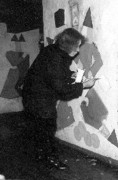 My exhibition GManu Scripta et Illuminatag shows my works from the late 80s and early 90s (handwritten books, and the more recent liturgical texsts in Latin (songs of praise, missal texsts and daily prayers)). At the seminar I will look at the history of calligraphy and its development from the early Middle Ages to the baroque. I will introduce different styles of writing, initcials, ornaments, book illumination. Also tools, materials, techniques. As a practical task we will learn how to write one of the simplest and the most wide-spread gothic script.
My exhibition GManu Scripta et Illuminatag shows my works from the late 80s and early 90s (handwritten books, and the more recent liturgical texsts in Latin (songs of praise, missal texsts and daily prayers)). At the seminar I will look at the history of calligraphy and its development from the early Middle Ages to the baroque. I will introduce different styles of writing, initcials, ornaments, book illumination. Also tools, materials, techniques. As a practical task we will learn how to write one of the simplest and the most wide-spread gothic script. I have studied design and interior design at the Tallinn Art University and also at the Villu Toots school of calligraphy. I have been active in the fields of graphic design, interior design, town planning and teaching art. At the moment I work as a restorer but in free time I paint, do calligraphy and I have lately also freed my hand at sculpture.
├Ľie Tilk
Via Sonora
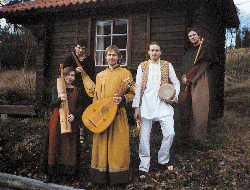
Musica Baltica
In Germany almost the whole treasury of 17th century music fell victim to wars, fires and annual spring cleanings. The libraries of Riga, K├Ânigsberg, Danzig and Stettin perished in the last war. What survived had been in the hands of bibliophiles: Sebastien de Brossard's collection in Paris, Duke August von Braunschweig's collection in Wolfenb├╝ttel and the D├╝ben family collection in Stockholm. The most complete archive of northern German vocal and instrumental music is constituted by the so-called D├╝ben Sammlung, a manuscript collection started in 1660 by the D├╝ben family of German composers in the employ of the Swedish court and kept since 1733 in Uppsala. This is a rear example of not only the richness of the repertoire of a 17th century court orchestra but even more of the varieties of music played in the Baltic countries which had come into the sphere of Swedish influence after the Thirty Years War and the peace of Westphalia.Here can be found printed Glamentsg (GKlag-Ges├Ąngeg) by organists from Riga and Stettin which they had composed on the occasions of death in the local ruling families. There are also imaginative instrumental pieces by composers not connected with the court or having only the flimsiest of ties with it. There are many pieces from Venice and Vienna, filtered here possibly through L├╝beck. After the Iron Curtain has come down, it is not easy to get used to the idea of musica baltica but it exists, due to the patronage of L├╝beck and German merchants. The emergence of an independent tradition then or later was not facilitated by the historical reality, turbulent even after the Thirty Years War. Still, the music imported from Vienna, Venice and central Germany could be so successfully enriched with the local dialects that at the end of the Hanseatic period a master could emerge, Dietrich Buxtehude, whose work summed up the aspirations of his predecessors which, with the addition of his own ideas, could merge into a uniform northern German style. Thus joined, improved and ennobled, the Hanseatic style contributed greatly to the music of the German late baroque period and the style evolved by Bach and H├Ąndel.
Even longer than the English-influenced pavan - here represented by an anonymous Fantasia for 7 viols and by a piece by the L├╝beck violinist Baltzar for 3 violins and basso continuo - in the cold north survived the choral. While L├╝tkeman had only tentatively transferred it form the ecclesiastical into the secular sphere, then Meder in 1700 incorporated it boldly as a character piece for ethnic minorities into programmatic music. Johann Fisher, Lully's wild pupil, invested it with Gserious pathosg. The suite, the most vigorous genre of the middle class and student music-making, was not yet standardised, but for the sake of compositional nobility it had already abandoned its Gdance valueg. The capriccio - a sequence of heterogeneous small phrases was taken to perfection by Johann Vierdanck, a student of the Mantovan violin virtuoso Carlo Farina.
The Grealg sonata was overshadowed by all this. Inventory lists show that sonatas from central Germany, Dresden and especially Vienna were highly appreciated but the local production was rare. The few surviving northern sonatas vary greatly. There are significant stylistic differences between the works of Vincenco Albrici who was from 1652 to 1654 the orchestral conductor at the court of Queen Christina, and joined her later in her exile, and Andreas Kirchoff, influenced by Schmelzer. Dietrich Becker's sonata for four violins is resounding music for the town hall antechamber, full of technical brilliance and sophisticated nuances of sound.
Musica Antiqua K├Âln
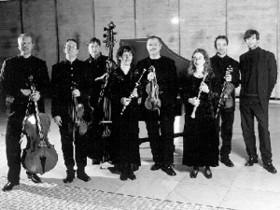
Musica Antiqua K├Âln and Reinhard Goebel
For more than 20 years, Musica Antiqua K├Âln and Reinhard Goebel have been associated with virtually every important musical center and festival at which early music is performed. The ensemble is renowned for their lively interpretations of 17th- and 18th-century works and for their virtuoso and imaginative historical performance practice.
Founded in 1973 by Reinhard Goebel and fellow students from the Cologne Conservatory, Musica Antiqua K├Âln initially devoted itself to the performance of Baroque chamber and sacred music. Musica Antiqua K├Âln's international breakthrough came in 1979, when the ensemble made its d├ębut at London's Queen Elizabeth Hall during the annual English Bach Festival and gave five concerts at the Holland Festival. On the occasion of their 10th anniversary, Reinhard Goebel augmented the ensemble's chamber-group nucleus with additional string and wind players to allow the performance of orchestral music as well both in the concert hall and in the recording studio.
Since 1981, Musica Antiqua K├Âln and Reinhard Goebel have made regular tours of the USA, visiting Australia and South America several times and touring China in GBach Yearg, 1985. Musica Antiqua K├Âln received the Buxtehude Prize from the City of L├╝beck and has also received awards from Siemens and the State of Nordrhein-Westfalen.
Musica Antiqua K├Âln has been sponsored by AHREND Germany, Office Equipment, since 1995. In 1981 the ensemble was named GArtist of the Yearg by the Deutsche Phonoakademie.
Reinhard Goebel was born in Siegen (Westfalen) in 1952. After leaving school, he took up his studies at the Cologne Conservatory with Franzjosef Maier, then with Saschko Gawriloff at the Folkwangschule in Essen, followed by an intensive course of study with Eduard Melkus and several years under the guidance of Marie Leonhardt. In addition, Reinhard Goebel studied musicology for several years at Cologne University. It was here that he laid the foundations of his immense knowledge of early music, a knowledge that is amply reflected in his ensemble's concerts and recordings. In the meantime, Reinhard Goebel and Musica Antiqua K├Âln have played an unprecedented role in increasing general awareness and knowledge of Baroque music.
Musica Antiqua K├Âln and Reinhard Goebel have been exclusive artists for the Archiv Production recording label since 1978. Their innovative role in the discovery and realization of unusual early music repertoire has been acknowledged internationally, as is apparent from the group's numerous awards: for example, their recording of chamber concertos by Telemann (Deutscher Schallplattenpreis 1981), the collections GGerman Chamber Music before Bachg (Deutscher Schallplattenpreis 1982) and GThe Bach Family before Johann Sebastiang Grand Prix International du Disque 1984), Couperin's Les Nations (Grand Prix National du Disque 1987), chamber music by J. S. Bach (Gramophone Award 1984), Telemann's Tafelmusik (CD Compact Award1990). Their recording of Heinichen's Dresden Concerti has won five major awards: the Jahrespreis der Deutschen Schallplattenkritik 1993, the Gramophone Award 1993, the Prix Caecilia 1993, the Schallplattenpreis Echoclassik 1994, and the CD Compact Award 1994.
Musica Antiqua K├Âln's recent releases include a recording of Handel's Marian Cantatas and Arias with Anne Sofie von Otter, which received the CD Compact Award 1995 in the GBaroque Vocalg category, and a compilation of works with a Parisian emphasis Rebel's Les El├ęmens, Gluck's ballet Alessandro and Telemann's Sonata in E minor. Their latest CD is a collection entitled Concerti per l'orchestra di Dresda with works by Heinichen, Veracini, Quantz, Dieupart, Pisendel, and Fasch. In the spring of 1996 the ensemble released a 2-CD set featuring sacred music by Heinichen, including the complete music for Holy Week, 1724 the oratorio Nicht das Band, das Dich bestricket and the GGood Friday Lamentationesg together with short psalm arrangements and two church sonatas. In the forthcoming years, Musica Antiqua K├Âln intends once again to devote itself increasingly to the music of the 17th century.
Florian Deuter - violin (J. Rogeri, Brescia 1713)
Reinhard Goebel - violin (Jacobus Stainer, Absam 1665) and viol (after Stainer, T. Muthesius 1994)
Isabel Schau - viol (after Stainer, Klier 1992)
Wolfgang von Kessinger - viol anonym (Flandern 1650)
Volker M├Âlier - viol (Leopold Widhalm, N├╝rnberg 1742)
Anke B├Âttger - viola da gamba (after R. Ch├ęroni, Michel Groppe, 1992)
Markus M├Âllenbeck - cello (Simon Gilbert, Metz 1756)
Christian Rieger - harpsichord (French/Germany, copy of an anonymous master, Joop Klinkhamer 1993)
North Indian classical music
North Indian classical music is one of the most highly developed art music in the world. Partaking strongly of improvisational elements, the structural framework of the music is provided by a system of melodic patterns called ragas and of rhythmic patterns called talas. Within the framework, the performers must create the musical fabric at the moment of performance.Following tradition, the musician doesn't perform a set program, but rather plays different ragas as inspired by the moment. The choice of raga is not usually a matter of whimsy: in accordance with centuries old philosophical traditions, certain ragas are considered to be appropriate to the specific time of the day, states of mind, and/or ethical considerations. (In this, the concept of raga is similar in some ways to the Greek philosophical concept of the modes).
Ragas are not to be confused with the Western notion of Gscalesg, while each raga has a characteristic pitch structure, much more is implied. The order in which the notes of the raga are introduced, and the manner in which the raga itself is revealed and unfolded are all extremely important. So, also, are matters of ornamentation, pitch alteration, and melodic structure.
Although notational systems exist, the tradition is largely an oral one, passed on by each master to students. Performances are appreciated by the audiences in many of the same ways as jazz improvisations: that is, performers are expected to demonstrate extensive knowledge of the traditions of the individual raga (in the same way a jazz musician is expected to know Gthe changesg). Nonetheless, in both traditions, the performer is admired when able to cast some new light on the familiar: it is the ability to honour the integrity of the raga while doing so in an intensely personal way that wins the greatest esteem.
The basic form for the interpretation of a raga is made up of four parts:
ALAP. This is a slow introduction where the performer contemplates the raga note by note, composing phrases, at first quite simply, with the two or three notes nearest the tonic, but gradually becoming more and more complex as he extends through the first octave - then over the whole range of the instrument. The alap is performed Gad libitumg rather like a Western cadenza, deriving momentum from the emphasis in the developing phrases. Much use is made of microtonal inflections, ornamentation and glissando. The artist, through his use of these means of expression, reveals his understanding of and sensitivity to the raga he is playing. A truly creative musician is always trying to draw out of a raga some hitherto unseen facet, by way of his improvisation.
JOD / JOR. When the artist feels that he has completed his exposition of the raga through the alap he introduces a rhythmic pulse into the music, starting again by playing short phrases against his regular striking of the drone strings. A new dimension enters the music. The improvisations become more and more extended - eventually with very fast staccato passages called Gtansg, full of rhythmic subtlety and requiring considerable technical virtuosity. As the tempo of the music increases the performer enters the next movement of the music.
JHALA. Here the artists starts playing triplets and quadruplets on the drone strings at an amazing speed, against which he plays phrases on the melodic strings, mostly in syncopation. Gradually he builds up to a climax, bringing to a close the first part of the performance.
GAT. This movement is really in GRondog form with the main subject being a previously composed motif (usually traditional), which is set to a recurring rhythmic cycle called a GTalg. The tabla player, whose main function is to mark this GTalg, accompanies the melody instrument to the end of the performance. As with the Western Rondo where the main theme returns after each variation, the Indian performer, having improvised for a few cycles will return either to the beginning of the theme, or to the first beat (the GSumg) of the new cycle (not necessarily the same). The theme, or gat, also serves as a time keeping pattern and the main performer may repeat the gat for several cycles while the tabla player improvises. It is usual for this whole movement to comprise of two gats, one slow and one fast. Near the end of the performance the melody instrument goes into jhala again to bring the performance to a climax.
Anindo Chatterjee
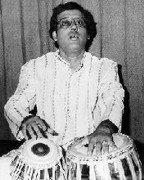 Anindo Chatterjee was born in 1953 in Calcutta and ranks today together with Zakir Hussain and Swapan Chaudhuri amongst the top tabla players in India. He started his music studies already at the age of five by the famous music teacher Gyan Prakash Ghosh. While performing worldwide as soloist as well as accompanist to the most outstanding masters of Indian classical music, Anindo Chatterjee has developed his distinct personal style. With his great creativity, immense experience and soft sound quality his concerts always offer a rich inner experience.
Anindo Chatterjee was born in 1953 in Calcutta and ranks today together with Zakir Hussain and Swapan Chaudhuri amongst the top tabla players in India. He started his music studies already at the age of five by the famous music teacher Gyan Prakash Ghosh. While performing worldwide as soloist as well as accompanist to the most outstanding masters of Indian classical music, Anindo Chatterjee has developed his distinct personal style. With his great creativity, immense experience and soft sound quality his concerts always offer a rich inner experience.
Ken Zuckerman
 Ken Zuckerman is internationally acclaimed as one of the finest sarod virtuosos performing today. He has completed twenty-four years of training under the rigorous discipline of Ustad Ali Akbar Khan and has performed with Maestro Khan in numerous concerts in Europe, India, and the United States. In addition to an extensive performance schedule, Ken Zuckerman directs the Ali Akbar College of Music in Switzerland in Basel and is also a teacher at the Music Academy of Basel where he conducts courses in both North Indian classical music and the music of the Middle Ages.
Ken Zuckerman is internationally acclaimed as one of the finest sarod virtuosos performing today. He has completed twenty-four years of training under the rigorous discipline of Ustad Ali Akbar Khan and has performed with Maestro Khan in numerous concerts in Europe, India, and the United States. In addition to an extensive performance schedule, Ken Zuckerman directs the Ali Akbar College of Music in Switzerland in Basel and is also a teacher at the Music Academy of Basel where he conducts courses in both North Indian classical music and the music of the Middle Ages.
Medieval Monophonic Songs - An Approach to developing styles of accompaniment
In this workshop students will be asked to prepare pieces (singer & accompanist/s), and we will discuss the possibilities for interpretation, maintaining the modal characteristics of song in the accompaniment, integrating improvisation, etc.
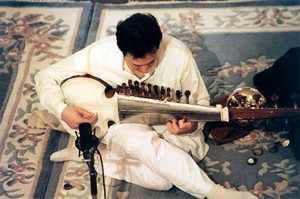
Modal Improvisation
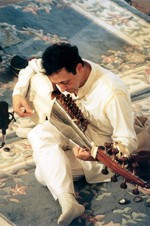 GWorkshop on Modal Improvisationg relates directly to our concert. Using some of the performance and pedagogical models from the monophonic imporovisation practice in India, I will show students of medieval music how they can develop procedures and exercises to practice improvisation. The workshop will be of a practical nature and I will give the students a number of melodic and rhythmic exercises that will give them a taste for this discipline.
GWorkshop on Modal Improvisationg relates directly to our concert. Using some of the performance and pedagogical models from the monophonic imporovisation practice in India, I will show students of medieval music how they can develop procedures and exercises to practice improvisation. The workshop will be of a practical nature and I will give the students a number of melodic and rhythmic exercises that will give them a taste for this discipline.
Laterna Magica
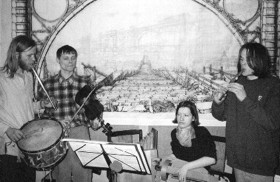
Taras Drak - lute, rebab, violin, recorders, cornamuse
Olga Komok - organ-portative, hurdy-gurdy
Dmitri Shickardine - violin, cornamuse, recorder
Stanislav Zoubtsov - pipe-and-tabour, flutes, tambourine, schawm
Laterna Magica was founded at the end of 1997 with former musicians of GGreen Sleevesg and some young performers, graduates of the St-Petersburg Conservatoire, students the St-Petersburg Academy of Culture and the St-Petersburg University. The ensemble focuses on performing medieval and folk music of Europe, though they have experience in performing Baroque, Renaissance and folk music of the Orient.
The ensemble is leading an active concert life in St-Petersburg (playing at different institutes, music schools and clubs as well as at the Museum of N.A. Rimsky-Korsakov, the St-Petersburg Union of Composers), they have also played in Helsinki, Prague and Krakow.
Deo Gracias, Anglia
English songs, dances and carols of 13th-15th c. 1. Te deum. English diskant, c. 1300
2. Edi beo thu (anon., later 13th c.)
3. Hail, Mary, full of grace (carol, 15th c.)
4. Alleluia : newe work (carol, 15th c.)
5. Motet (dance-song, 13th c.)
6. Alma redemptoris mater (carol, 15th c.)
7. Dance (anon., c. 1240)
8. Hoc in anni januor (students' song, 13th c.)
9. Ah, man, assay (carol, 15th c.)
10. Dance (13th c.)
11. An heavenly song (Carol, 15th c.)
12. Estampie (anon., c. 1325)
13. Deo gracias, Anglia (carol, 15th c.)
14. Dance (13th c.)
15. Lullay lullow (carol, 15th c.)
and a small spanish part of the program:
16. O Virgo splendens (14th. c.)
17. Stella splendens (14th. c.)
18. Como podem per sas culpas (cantiga de Santa Maria)
The Living Legacy of Ziryab
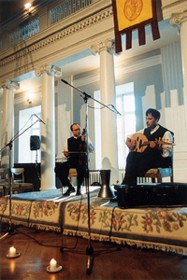 AL TARAB:
AL TARAB:
Abdalaziz Samsaoui
canum, kemanja, darbuka
Otman Almerabet
ud, saz
Kontserdi kava:
Fatiha
Sufi (esperitual melody)
Taksim
Muashaha I (uzubia)
Muashaha II (loma bada)
Laberinto
Parfume du gitane
Jezal
Lili
Al tarab
Abdalaziz Samsaoui - canum, kemanja, darbuka
Otman Almerabet - ud, saz
Tarab, in Arabic, means impressions or feelings which are evoked in the soul by music. In Muslim Spain this form of art was associated with cosmic processes and the different states of the human soul. In Andalusia came into being an elaborate and sophisticated style of music which found its source in Magrib, Spanish and Middle Eastern cultures. Ziryab's Persian sophistication, Arabian moderation and Berber joy of life commingled with the Visigothic and Jewish heritages, creating thus an original form of art for the caliphate and later the Taifa kingdoms.
Otman Almerabet 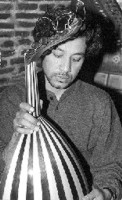 Since childhood Otman Almerabet has been performing music in various styles: Andalusian, Egyptian, Syrian, Persian, Sufi and Turkish music. In 1982, whith his brother, he founded a flamenco-influenced group GAl Maqamg. In 1984 he was the founder, together with Magrib and Andalusian musicians, of the group GAl Tarabg (GArt of Listeningg) which has been very popular at all festivals of ethnic music (in Seville, Cadiz, Granada, Madrid, Barcelona etc.) and outside Spain (in California and elsewhere). He has worked together with such acclaimed musicians like Chano Dominguez (flamenco-jazz), Javier Rueval, El Lebrijano (Arabian-Andalusian music), Jorge Pardo (jazz-flamenco). He has also performed with the well-known Armenian musicians Haig and Souren.
Since childhood Otman Almerabet has been performing music in various styles: Andalusian, Egyptian, Syrian, Persian, Sufi and Turkish music. In 1982, whith his brother, he founded a flamenco-influenced group GAl Maqamg. In 1984 he was the founder, together with Magrib and Andalusian musicians, of the group GAl Tarabg (GArt of Listeningg) which has been very popular at all festivals of ethnic music (in Seville, Cadiz, Granada, Madrid, Barcelona etc.) and outside Spain (in California and elsewhere). He has worked together with such acclaimed musicians like Chano Dominguez (flamenco-jazz), Javier Rueval, El Lebrijano (Arabian-Andalusian music), Jorge Pardo (jazz-flamenco). He has also performed with the well-known Armenian musicians Haig and Souren.
He has summed up his career as a lute player fifteen years ago with his research into the ethnic music and instruments of Northern Africa, the Middle East and Andalusia. His resulted in a number of documentaries for television (in England, Germany, France, Italy, the United States). At present he is the head of the Dar Ziryabi Cultural Centre and is engaged in preserving and teaching early Andalusian music and creating a site for the coming together of three cultures with common history which constitutes the living legacy of Andalusia.
 Abdalaziz Samsaoui was born in Marrakech. He has studied at the Andalusian school in Tetuan under Amin Al-Akram. He has played in the Youth Orchestra in the Andalusian Music Conservatory, with which he has also given solo concerts at state festivals. Andalaziz has also been a member of a number of groups playing both ethnic and classical music (Alvan) and has taken part in the recording sessions of such Spanish early music consorts as Cino Siglos and Alia Musica. As a soloist he plays the violin and canum.
Abdalaziz Samsaoui was born in Marrakech. He has studied at the Andalusian school in Tetuan under Amin Al-Akram. He has played in the Youth Orchestra in the Andalusian Music Conservatory, with which he has also given solo concerts at state festivals. Andalaziz has also been a member of a number of groups playing both ethnic and classical music (Alvan) and has taken part in the recording sessions of such Spanish early music consorts as Cino Siglos and Alia Musica. As a soloist he plays the violin and canum.
The short history of ud
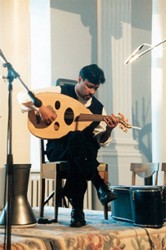 Saib Khatir (AD 683, the Umayyad period) was a musician who accompanied his songs on an instrument called zalzal (AD 791), improved its design and renamed it ud al sabbut. It took the place of old Arabian ud (Mizhar) and the Iraq ud.
Saib Khatir (AD 683, the Umayyad period) was a musician who accompanied his songs on an instrument called zalzal (AD 791), improved its design and renamed it ud al sabbut. It took the place of old Arabian ud (Mizhar) and the Iraq ud. Thanks to Ziryab, who was forced to leave Bagdad, move to Kiraouan (822) and then to the capital of the Umayyad caliphate Ckrdoba, a revolution in the design, handling and repertoire of this instrument was carried out.
This talented founder of the Andalusian school of music inverted also the fifth string (Gas red as bloodg) between the second and the string of ud which supplemented the four moods, stood for the soul and symbolised life; he also decreased the weight of the instrument by one third due to new materials.
Making the strings was special: the first two strings (zir, Mathna, bamm) were made of gut to give them a melodious, clear and dense sound. The instrument became stronger and was better able to withstand changes in temperature. The wooden plectrum (Mizrab) was replaced by a plectrum made of eagle's feathers to make playing easier and the sound more intense when the strings were plucked gently and swiftly.
Using the technique worked out by the venerable Ziryab, we have, since devoting ourselves to this act, been combining the study of customes (tab aquam), rhythm (Iqa, Mizan) and improvised singing.
Lute player Otman Almerabet describes the nature of improvisation (Taqsim) thus:
GThe moment I take my ud, I don't know yet what I'm going to play. Plectrum touches the strings softly and calmly. When playing, the melody never repeats itself, it is the beginning of a musical journey. I penetrate the deepest depths of my soul and explore the distant past of our ancestors' heritage. Improvisation and my spontaneous creation come into being in an abundance of forms and colour, with a free rhythm, far from the constraints of established taste or aesthetic structures.g
Tower Music
Daniel Speer: Two tower suites
Johann Valentin Neder: "Mattaglia"
Johann Pezel: "Two tower suites"
Michael Praetorius: "Brand Simple"
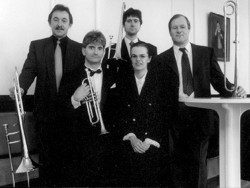
Tallinn Baroque

Kaia Urb (soprano); Raivo Tarum (baroque trumpet); Priit Aimla (baroque trumpet); Aabi Ausma (trombone); Valter J├╝rgenson (trombone); Imbi Tarum (harpsichord); Peeter Margus (alto trombone); Olev Ainom├Ąe (schawms)
The ensemble plays the music of the 17th and 18th centuries, when guilds of brass players were formed at churches and courts and they were given a privileged status. The musicians were obliged to serve either the king, the prince, the emperor or the church and not to perform anywhere else. It was believed that the sound of brass instruments - trumpets, cornets, trombones - best expressed the nobility of the royal throne as well as the divine might and nobility. Such guilds were active, for example, in Bologna, Venice - where the band of St. Marcus Church consisted only of trumpets, cornets and trombones, the court of Emperor Leopold in Venice and Salzburg as well as in Leipzig, Dresden, N├╝rnberg, Berlin and Hamburg.
During the baroque period the art of singing was considered to be the highest musical art, as the singers glottis is the most perfect of all instruments and besides voice the singer also expresses himself with the help of words. This is why the instruments resembling human voice were most highly valued. So it was believed that the sound of the trumpet resembles the voice of the soprano and the contra-tenor, the sound of the cornet resembles the voice of the chorister, the sound of the tenor trombone that of the tenor and the sound of the bass trombone the voice of the basso.
As in rule, there was always an accompanying instrument in the ensemble, which could be either a harpsichord or an organ. Both were also used as outstanding solo instruments.
All the above mentioned has determined the composition of our ensemble and the choice of repertoire. The ensemble performs on instruments belonging to the times when the music was composed. This provides the listener with a overview of the development of the instruments, their sound and playing possibilities during earlier times.
Tallinn Baroque - concert programme
Giovanni Bassano
"Vestiva I colli" zink, harpsichord
Johann Rosenm├╝ller (1620-1684)
"Lieber Herre Gott" - soprano, two trombones, b.c.
Juan Cabanilles (1644-1712)
Passacalles de primer tono harpsichord
Cesario Gussago
Sonata "La Cornala" - alto schawm, alto trombone, tenor trombone, bass trombone
Tarquino Merulo (1594-1665)
"Jesus dulcis memoria" - soprano, zink, schawm, b.c.
Giovanni Battista Buonamento
Sonata a6 - zink, schawm, three trombones, b.c.
Tomas Milans (ca 1685-1759)
"Quam vidistis, pastores"
"Sanctum, et terrible nomen ejus" - soprano, harpsichord
Daniel Speer (1636-1797)
Two sonates - zink, schawm, three trombones, b.c.
Anonymous (Spain)
"Batalla Famossa" - harpsichord
Samuel Scheidt (1587-1654) ┬┤
Cancione - zink, schawm, three trombones, b.c.
Michael Altenburg
Intrada "Ein feste Burg" - soprano, zink, schawm, three trombones, b.c.
Dan Laurin
 Dan Laurin was born in J├Ânk├Âping, Sweden, in 1960. In 1976, as an autodidact, he started his recorder studies at The Funen Conservatory of Music in Odense, Denmark. Dan Laurin's teachers were the late Ulla Wijk and Paul Nauta. In 1979 Dan Laurin received his Diploma and continued his studies in Copenhagen, were he made his debut in 1982. Dan Laurin had then spent half a year in Holland, taking lessons from amongst others Walter van Hauwe. The contact with professors Braun and van Hauwe was instrumental for his interest in contemporary recorder music.
Dan Laurin was born in J├Ânk├Âping, Sweden, in 1960. In 1976, as an autodidact, he started his recorder studies at The Funen Conservatory of Music in Odense, Denmark. Dan Laurin's teachers were the late Ulla Wijk and Paul Nauta. In 1979 Dan Laurin received his Diploma and continued his studies in Copenhagen, were he made his debut in 1982. Dan Laurin had then spent half a year in Holland, taking lessons from amongst others Walter van Hauwe. The contact with professors Braun and van Hauwe was instrumental for his interest in contemporary recorder music.
The past 20 years Dan Laurin has been teaching on every possible level at academies of music in Scandinavia and Germany. Since 1980, he has held posts at the following academies: The Funen Conservatory of Music in Odense, Denmark (now The Carl Nielsen Academy of Music), The Conservatory of Music in Aalborg, Denmark, The Conservatory of Music in Gothenburg, Sweden and The Royal Conservatory of Music in Copenhagen, Denmark. In 1992, Dan Laurin was appointed assistant professor of the recorder and interpretation of baroque music at The Carl Nielsen Academy of Music, and the following year he was appointed professor of the recorder at the Hochschule f├╝r K├╝nste in Bremen, Germany. For years, Dan Laurin conducted several lectures in Swedish and Danish radio on subjects like music aesthetics, as well as reviewing books and articles on music. He has been responsible for developing the Musician/Performer education at The Carl Nielsen Academy of Music, a new concept focusing on contemporary music including stage technique, public relations, music technology, improvisation and body training. In the coming years, Dan Laurin will be guest professor at The National University for Fine Arts and Music, Tokyo.
Dan Laurin has been conducting master classes on a fairly regular basis in Sweden, Denmark, Norway and Germany as well as in Australia, Japan and the United States. His teaching schedule also includes lectures on as diverse subjects as GThe Neoplatonic Musical Universeg, GImprovisation Practices in the 16th- and 17th century Musicg and GContemporary works by Japanese composersg.
Last year Dan Laurin was awarded a Danish government grant enabling him to do research on recorder acoustics and sound techniques, the results of which will be published. The research, which aims at developing an individual recorder sound, is carried out in collaboration with leading scientist professor Joe Wolfe at The University of New South Wales, Sydney, Australia, and Clas Pehrsson, The Royal Academy of Music, Stockholm, Sweden.
Dan Laurin has been fairly busy on the international concert stage for the past 10 years, following London (Purcell Room) and Paris (Louvre and Le Chatellet) debuts in the late eighties. He performs with his own groups as well as with orchestras like Drottningholm Baroque Ensemble, Bach Collegium Japan, The Lithuanian Chamber Orchestra and Berlin Phil. The 1998 itinerary included three tours to Japan and two tours to USA, performances in London, Berlin, Estonia and the Scandinavian capitals. In 1999 Dan Laurin will perform at The Boston Early Music Festival as well as tour extensively in Japan, Estonia and Israel.
Dan Laurin's recording contract with the BIS label keeps him very busy, and the Vivaldi release late 1993 was received as GStern des Monatsg by FonoForum, the foremost magazine on music in German 1994 saw three more releases: GThe Japanese Recorderg, Telemann/J.S. Bach/C.Ph. Bach and GThe Swedish Recorderg, including recorder concertos by Jan Sandstr├Âm and Swedish jazz flutist Bj├Ârn Jason Lindh as well as other works commissioned for him. The latter recording earned Dan Laurin the Swedish Association of Composers' prize as best performer of Swedish contemporary music. In 1995, Dan Laurin was awarded a GGrammyg for these four BIS albums. Later releases includes French flute sonatas, Telemann chamber music, Vivaldi concertos with GBach Collegium Japang, the Holmboe recorder concerto, the Handel sonatas, English concertos by Babell, Woodcock and Bastom with GWassenaer Ensembleg and the complete GDer Fluyten Lust-Hofg (9 CDs) by Jacob van Eyck, the world's largest solo work for any wind instrument.
In 1997 Dan Laurin was elected member of the Royal Swedish Academy of Music.
********
A few words about the instruments: The g altos have a dark, powerful sound which I find suitable for some of the slow movements. The construction principles of the larger instruments allow more differentiation in tone colour, providing interesting dynamics for the slow, melodic themes.
The so-called Rosenborg soprano is one of a small number of surviving instruments which have been around in van Eyck's life-time. The original instrument is kept in Rosenborg Castle, a beautiful renaissance castle, a couple of minutes' walk from where I live in central Copenhagen. The recorder is a precious instrument made of an exquisite material: narwhal tooth.
Both my instrument makers live down-under: Fred Morgan lives in Daylesford, a couple of hour's drive from Melbourne, Australia. Paul Whinray lives in Te Henga at the shores of the northern island of New Zealand. None of my work would have been possible without these unique artists. Thank you both.
Concert "Recorder recital"
Preludium of VorspeelFantasia & Echo
Geswinde Bode van de Min
(GPrelude, in Latin/Dutchg). Renaissance instrumentalists tuned and warmed up by improvising preludes, and printed music collections often opened with such pieces. No doubt Van Eyck often announced his presence in the Utrecht Janskerkhof with pieces such as this one which opens the Lust-hof: a good introduction in miniature to the flourishes, scales, and echoes to come.
The echo-fantasia was a genre nurtured especially by the Dutch, usually for organ. Van Eyck's slow, mode-defining opening is typical; the echoes arise once the piece is established. The Lust-hof's only dynamic markings are found here, accentuating the echo effect caused naturally by the octave leaps in the recorder's modest range.
(GSwift Messenger of Loveg). The source of this tune is obscure, but it was widely known in the Netherlands, beginning in the 1630s with a pastoral text of a shepherd bewailing his lost-love cause to Cupid. In the Lust-hof however, the tune has been altered so that the original text is no longer singable.
Psalm 68
(A psalm of war: Arise O Lord and show your strength). One of the best-known and fiercely-loved of all the Genevan psalms, Psalm 68 became the battle-anthem of the rebel Calvinists in the religious struggles of the16th century, because of its militant view of God's wrath toward the unrighteous. Longer-lasting fame (now with a penitent text) has come to the tune via Bach's settings of it as the Lutheran chorale GO Mensch bewein' dein' S├╝nde grossg in the Orgelb├╝chlein and the St. Matthew Passion.
Almande prime roses
(GPrimrose almandeg). Another Dutch setting of this tune is paired with a GBrande Mr Primrose,g suggesting a link to an obscure English composer by that name, but a Dutch songbook calls it GBeaux jeux agreable Tiransg (which fits the opening melody well), suggesting an air de cour origin.
Ach Morderesse
La Bergere
(GAlas, murderessg). The murderess is the shepherdess Galathea whose flinty heart slays her faithful shepherd suitor Tyter, or so he claims. A Dutch songbook staple for several decades after the 1620s.
(GThe shepherdg). The tune is Pierre Gu├ędron's 1620 air de cour GSus, sus, sus, Bergers et Bergeretttesg (Come, come, shepherds and shepherdesses), cited in several Dutch songbooks. Marin Mersenne printed a setting of this tune (untitled and misattributed) for flute quartet in his Harmonie Universelle of 1636.
Derde Carileen
(GThird Carolineg). There were in all five tunes named for the shepherdess Carileen in the mid-century Dutch repertoire; they are found both separately and as a set. At least the first three come from English theater. This tune was written by William Lawes as a sinfonia for a 1638 masque; it's the usual boy-wants-girl pastoral romp. Caroline texts have been found only for the first two in the set; presumably the last three had them also. To a lesser extent than the first two Carileens, the Third is found in various Dutch bergerettes and instrumental collections.
Doen Daphne d'over schoone Maeght
Stil, stil en reys
(GWhen Daphne the most beautiful maidg). Modern recordings have made Daphne one of the hits of the Lust-hof, but it was a 17th-century favorite as well. The text and tune come from a 1610s English ballad telling the classical tale of how Phoebus Apollo pursued Daphne so relentlessly that in desperation she cried out to the goddess Diana to turn her into a laurel tree.
(GHush, hush a momentg). A French court dance made famous by its inclusion in Michael Praetorius' monumental Terpsichore of 1612, this dance tune is found in sources from Rome to Scotland to Sweden throughout the 17th century. In the Netherlands, the tune was well-known for its text by Jan Starter praising the beauty of women-piece by piece, stanza by stanza.
Engels Nachtegaeltje
(GEnglish nightingaleg). Astonishingly, there are words to this quintessentially onomatopoetic tune, a 1630s English ballad about how the nightingale's sweet song refreshes the tired senses of city dwellers; the second half of the tune mimics the bird song with the words Gsweet sweet jug jug....g The tune is found in dozens of settings from all over northern Europe for a great variety of instruments, but Van Eyck was the only composer who had the idea of making the nightingale wax increasingly virtuosic.
Si vous me voules guerir
Courante
(GIf you want me to recoverg). Most of this French title made it to the Netherlands, but Francois de Chancy's 1635 air really read, GSi vous ne voulez me guerir.g In either case, it's a tale of frustrated love, but Van Eyck''s uncommon dotted-rhythm variations remain sprightly and unaware of it.
Baubles of French court life in the form of courants, airs, ballets, and sarabandes littered the landscape of Dutch bergerettes and instrumentalmusic in the 17th century. The source of the unnamed ones is as hard to identify as the proverbial needle in the haystack.
Wat zalmen op den Avond doen
(GWhat shall we do in the evening?g). The only originally German secular song in the Lust-hof, this rowdy come-on ballad is found in many late 16th-century German lute manuscripts. Its very simplicity makes it a perfect base for variation; Van Eyck gives it a runaway high of thirteen times while also using a greater variety of rhythmic patterns than he used in any other piece.
Viljandi Linnakapell
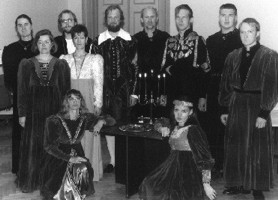
Helika Gustavson (vocal); C├Ątlin Jaago (bagpipe); Sandra Sillamaa (bagpipe); Anu Taul (bagpipe); Neeme Punder (flutes, rauschpfeiff); Siiri K├Ąrt (fiddle, rebec); Saale Uusma (rebec); Margus Kubo (rebab); Toivo S├Ámer (lute); Marge Loik (percussion, bells, cornamuse); Anti Einpaul (recorders, shawms, cornamuse); Arno Anton (horn, trombone); Peep Heinaste (sepherd's horn)
artistic director - Neeme Punder
Viljandi Linnakapell was founded by the flute teacher T├Ánu Sepp who taught at the local children's music school. At first only students and teachers were involved but in 1989 the group grow bigger and was given official status. After T├Ánu Sepp left Viljandi the group was headed by its member Margus Kubo and later Peeter Klaas from Hortus Musicus. During the years 1989-1991 and again since 1998 the group is lead by Neeme Punder, the flute soloist of Hortus Musicus.
The group plays music from the Middle Ages to the Baroque. Besides performing in Estonia, it has toured in Finland, Sweden, Denmark, Germany, Lithuania and Russia.
The present programme consists of medieval songs and instrumental pieces.
Neidhart von Reuenthal (born c.1180, died after 1237) was a well-known German minnesinger who started his career at the court of Duce Otto II of Bavaria. A surprising number (68) of his poems have survived, 29 of them are Gsummer songsg and 39 Gwinter songsg. The songs are preceded by an introduction describing nature as it is in that time of the year. He uses stanza forms and rhymed verse. His music was innovative and inspired many imitators.
The French trouvere Guillaume li Vinier was active between 1190 and 1245 and was one of the most outstanding poets of the Arras region is the first half of the 13th century. He wrote love songs, ballads, nature poems and poems dedicated to the Virgin Mary.
Guillaume d'Amiens, active at the end of the 13th century, composed songs and illustrated manuscripts.
Trouv├ęre Guillebert de Berneville was active in south-west Arras between 1250 and 1280. His verse forms are imaginative but melodies usually simple. His song GCuidoient li losengierg is written in the rortruenge form characterised by a refrain after every three to five stanzas.
Medieval music is open to interpretation as the choice of instruments and the way music is performed is left to the musician to decide. Viljandi Linnakapell offers a rich selection of rhythms and arrangements, and beside medieval instruments they use Estonian herdsman's horn and bagpipe.
Ecco la Primavera
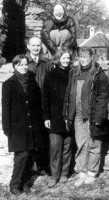
Eva Rummo - recorder
Kai-Riin Kont - recorder
Ene Nael - harpsichord
Natalia Kostr├Ákina - recorder
T├Ánis Kuurme - dulcian, recorder
First came together in 1998 as the project group which comprised three generations of Estonian early music players. The name GEcco la Primaverag reflects the aspiration of the group to approach music without prejudice, as being always fresh, like the rebirth of nature in spring. The musicians strive for unity with the ways of thinking of the early musicians and with each other on the one hand, on the other, they are willing to take liberties, like when trying out unusual combinations of players in playing music originally written for gamba or broken consorts.
The present programme, GA la Espanag, is the group's third, the former two were of Italian and English music. In every programme the accent is laid on the one period, region or composer. In this programme this person is the composer and the gamba virtuoso Diego Ortiz (1510-1570).
The group would like to express their thanks to Early Music Studio Cantores Vagantes for an opportunity to use their instruments and rehearsal facilities.
Sepharad
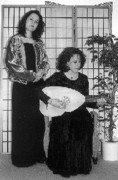 Ana Isabel Arnaz - vocal
Ana Isabel Arnaz - vocal
Amaya Oliver - lute
Ana Isabel Arnaz commenced her studies at the Miguel Fleta Music School in Huescas. At eleven she started taking singing lessons, first with Mayi Amieva and later with Conrado Beltrani. She then continued her studies at the Conservatorio Superior del Lyceo's in Barcelona where she was awarded a grant for studying romantic opera. In 1997 she became a student at the department of renaissance and baroque music at the Schola Cantorum Basiliensis where she studies under Richard Levitt. She has been soloist with groups like Coral Oscense, Orquestra Concerto and Coro de Camera del Palau de la Musica in Barcelona.
Amaya Oliver studied with Jos├ę Louis Rodrigo in Conservatorio Superior de Musica de Madrid and got a diploma as a guitarist in 1992. She has participated in master classes with David Russell, Leo Brouwer, Jos├ę Miguel Moreno and Hopkinson Smith. She has performed with the guitar duo Crescendo, the guitar and flute duo Syrinx and such early music consorts as Orphenica Lyra and Armes Amour. She has also contributed to music journals like Ritmo and Scherzo and the recording company Glossa. She studies medieval lute at the Schola Cantorum Basiliensis with Crawford Young and sarod and Indian music with Ken Zuckerman.
The Moorish king passing through the city of Granada
Paseavase el rey moro (Narvaez)
Cavalleros de Alcala (Cancionero de Palacio)
La rosa enflorece (Sephardish song)
Fantasia (Milan)
En memoria de Alixandre (Cancionero de Palacio)
Gazal (andalusi egypcio)
Isabel (Mudarra)
Qu├ę es de ti desconsolado? (Cancionero de Palacio)
~
Si me llaman a mi (Mudarra)
Claros y frescos rios (Mudarra)
Una sanosa porfia (Cancionero de Palacio)
Soy contento y vos servido (Encina)
De Anteguera sale el moro (Fuenllana)
El rey de Nimrod (Sephardish song)
Muashaja
Paseavase el rey moro (Pisador)
PASEAVASE EL REY MORO POR LA CIUDAD DE GRANADA
(The Moorish king passing through the city of Granada)
In the year 711 the Arabs entered the Peninsula from north Africa. During eight centuries of living together with the Christians and Jews, there was a great cultural development based on the mutual enrichment. In 1492 the Catholics reconquered Granada and completed Gla Reconquistag. Some years after thousands of Muslims and Jews were expelled from the peninsula by the Catholic Kings. This was the end, but the cultural richness still remained in the character of each form of art in the Spanish renaissance.
The intention of Sepharad is to transmit to the public the common points of these three cultures through the music of this time. The collaboration of Al Tarab is something special in this concert, because it represents an important part of this story.
The Tallinn Baroque Orchestra
 The Tallinn Baroque Orchestra gave its first concerts in June 1986 and is closely connected with the development of early music interpretation in Estonia. At present it is the only orchestra here which plays on period instruments, being one of the few continuously active baroque orchestras in eastern Europe. The Talinn Baroque Orchestra has developed into an independent and prominent orchestra, its musicians represent the best performers of baroque music in Estonia. The extensive repertoire ranging from the early baroque to classicism (plus modern Estonian music) requires excellent qualities from the musicians. The artistic leader and the initiator or the orchestra is its manager and leading cellist Egmont V├Ąlja.
The Tallinn Baroque Orchestra gave its first concerts in June 1986 and is closely connected with the development of early music interpretation in Estonia. At present it is the only orchestra here which plays on period instruments, being one of the few continuously active baroque orchestras in eastern Europe. The Talinn Baroque Orchestra has developed into an independent and prominent orchestra, its musicians represent the best performers of baroque music in Estonia. The extensive repertoire ranging from the early baroque to classicism (plus modern Estonian music) requires excellent qualities from the musicians. The artistic leader and the initiator or the orchestra is its manager and leading cellist Egmont V├Ąlja. Though the orchestra usually performs without directing, it has worked with many famous conductors (W. Kuijken, H. Gebhart, L.Kr├Ąmer, S.Layton and others), choirs and soloists (S.-L. Kaakinen, K.-M. Kentala, M. Bellini, I. Monighetty and others). In August last year the orchestra and the ensemble Studio Vocale performed with Toomas Siitan all the twelve preserved Cantatas by Nicolaus Bruhns. In this season they have performed concert series introducing Wolfgang Amadeus Mozart and Music from the World.
In addition to active concert performances the Tallinn Baroque Orchestra has made recordings for different Estonian radio stations and the Estonian Television. In 1997 were recorded CDs with Purcell's opera Dido and Aeneas, Vivaldi's The Four Seasons, Bach's St. Mark Passion with Hans Gebhard. The orchestra has performed at various festivals in Scandinavia and elsewhere in Europe.
The Tallinn Baroque Orchestra has taken part in all Haapsalu Early Music Festivals, both in the cast of grand vocal works and with separate programmes. The most memorable moments of the festival have been H├Ąndal's Messiah, performed with Haapsalu Festival Choir and soloists in 1995, and the concert performance of Purcell's Dido and Aeneas in 1996.
Kreeta-Maria Kentala
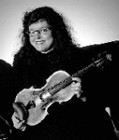 Kreeta-Maria Kentala has studied the violin at the Sibelius Academy in Helsinki and at the Swedish Radio Music School. She has also studied early music in Amsterdam. She has appeared as an orcestra and chamber musician in Finland and abroad with the Finnish Radio Orchestra, Ostrobothnian Chamber Oschestra, Musica Antiqua K├Âln and Ensemble Sonnerie. From autumn 1996 has taught the violin at the Western Helsinki Institute of Music and the Ostrobothnian
Kreeta-Maria Kentala has studied the violin at the Sibelius Academy in Helsinki and at the Swedish Radio Music School. She has also studied early music in Amsterdam. She has appeared as an orcestra and chamber musician in Finland and abroad with the Finnish Radio Orchestra, Ostrobothnian Chamber Oschestra, Musica Antiqua K├Âln and Ensemble Sonnerie. From autumn 1996 has taught the violin at the Western Helsinki Institute of Music and the Ostrobothnian Conservatory of music.
ALBA
ALBA was formed in connection with the first Copenhagen Early Music Festival in 1992 and the Spanish exhibition at the art museum Louisiana the same year. Thus, a Danish professional medieval ensemble was born.
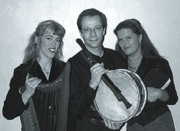 From the first years ALBA has focused on the task of mediating the music of the Middle Ages in such a way that it can captivate the modern audience as an art form, not just a historic curiosity. By examining surviving original sources of both writings and visual arts, and by studying the still living musical traditions with roots in medieval time, ALBA first of all searched for the timeless state of emotion, which in spite of the distinctive character of both the music and the instruments, lives in music from all times. They then flavour it with a mixture of authenticity and personal expression.
From the first years ALBA has focused on the task of mediating the music of the Middle Ages in such a way that it can captivate the modern audience as an art form, not just a historic curiosity. By examining surviving original sources of both writings and visual arts, and by studying the still living musical traditions with roots in medieval time, ALBA first of all searched for the timeless state of emotion, which in spite of the distinctive character of both the music and the instruments, lives in music from all times. They then flavour it with a mixture of authenticity and personal expression.
Much like the travelling musicians of medieval times, ALBA does not demonstrate a great variety of plausible (and implausible) instruments, but does both vary and contrast their music with a virtuous and subtile control of the innumerable possibilities of their instruments. Their programmes expose the countless colours and diversities of the Middle Ages, often with a mixture of both words and music.
ALBA can be heard as a duo with Agnethe Christensen and Poul H├Şxbro or as a trio in company with the singer and harpist Miriam Anders├ęn. A concert with ALBA is an invitation to experience the refinement of the Middle Ages, with music for both body and soul.
Poul H├Şxbro from Denmark graduated in 1994 from the Carl Nielsen Academy of Music with recorder as his main instrument, and is now employed there as co-ordinator of the musicianship/performer course. With a background as a rock drummer and performer of Andean folk music, and several years of great interest in contemporary music - giving many first performances - he has now since 1992 chosen to use this many-faceted background to revive the in medieval time so popular instrument-combination pipe-&-tabor(s). With these old and at the same time so novel sounds he is often a guest at the modern musical scene.
Agnethe Christensen, alto, comes originally from Sweden and has her roots in both classical and folk music. She studied at the Royal Danish Academy of Music and Schola Cantorum in Basel, and has participated in a large number of solo recordings for different radio stations and for CD productions, as well as giving concerts and master classes in early music. She also appears at the opera stages performing mainly modern and baroque opera.
Miriam Anders├ęn discovered medieval music when participating in the vocal ensemble ?Schola Gregoriana Holmiae?. Before going to Schola Cantorum in Basel, she studied calligraphy and book-binding in London, worked as a calligrapher while also gaining experience with theatre and circus. Today, Miriam Anders├ęn works as a freelance musician with medieval ensembles, e.g. Real, Sarband, Ensemble Ferrara and Discantus, but still at her agenda are theatre and experimental music projects.
Pipe-and-tabor/psaltery: the combination one-hand flute and tabor was widespread all over Europe in medieval time, from Sweden in the north to Spain in the south. With dance, both at the castle and in the village, as mealtime music, accompanying tournaments and theatre; even with church ceremony and at the battlefield, it has been possible to hear this cunning one-man ensemble, alone or together with other instruments. The flute, played with one hand, can be found in many sizes. It has three holes and a range of nearly two octaves. From the hand or the wrist hangs a drum, striking with the drum pin on both skin and edge in accompanying rhythms. This drum may be substituted for a triangle, as seen in a town hall painting in Sienna (Italy), or with a chorus (string drum) as in a few places still in Spain and southern France; a number of strings are stretched over a resonance box, tuned with the flute and then played as a drum. Often, a musician is seen to play different- or equally-sized pipes simultaneously, which enables to also play the burden, in parallel intervals or in simple polyphony. In most places, the pipe-and-drum disappeared during the course of the 16th and 17th century, but it can still be heard today as part of the folk music tradition in both Spain and France.
Tar: Frame drums were among the most common types of percussion instruments in the same period, either with small cymbals as on the modern tambourine, or without, as seen in a fresco in Bellinge at Funen in Denmark. Here, as well as on other reproductions, the drum is held vertically and hit on the skin with the free hand. This technique, still in use throughout the Orient, enables a very varied playing and numerous sound variations and explains its great popularity all through medieval time.
Donnas das Donnas
Prologo
Miragres fremosos
Dized' ai, trobadores
A Santa Maria (Instrumental)
Nenbressete Madre de Deus Maria (Instrumental)
Virgen Madre gloriosa
Santa Maria amar
A Virgen Santa Maria (Instrumental)
Por foltenno quen na Virgen
Tod' a queste mund'a loar
Como o nome da Virgen
Songs from GCantigas de Santa Mariag
This collection of over 400 songs comes from Spain and is one of the greatest musical documents of the Middle Ages. The manuscript stems from the court of Alfonso X (1221-1284), King of Castile and Leon, also known as Alfonso the Wise. His court was one of the main cultural centres of Europe, and evidence shows that musicians of many nationalities came together there to perform these cantigas. There is little doubt as to the Gworld-musicg atmosphere that prevailed at the court, and it is with this in mind that ALBA has selected and arranged some of the songs from this magnificent collection.
Rondellus
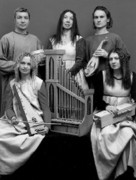 Early Music Consort Rondellus was founded in 1993 at the instigation of Maria and Robert Staak with the aim of performing Medieval and Renaissance music. Depending on the programme the consort consists of either two to six singers and instrumenta-lists. The members of the consort are professionals, who have been active in well known Estonian early music groups for years. Rondellus has successfully toured in the Baltic states, in Scandinavia, Poland, Germany and Spain. The founders Maria and Robert Staak form the core of the group, they select the music, prepare programmes and engage other musicians if the necessity arises.
Early Music Consort Rondellus was founded in 1993 at the instigation of Maria and Robert Staak with the aim of performing Medieval and Renaissance music. Depending on the programme the consort consists of either two to six singers and instrumenta-lists. The members of the consort are professionals, who have been active in well known Estonian early music groups for years. Rondellus has successfully toured in the Baltic states, in Scandinavia, Poland, Germany and Spain. The founders Maria and Robert Staak form the core of the group, they select the music, prepare programmes and engage other musicians if the necessity arises. Maria Staak - vocal
After graduating from the stage department of the Estonian Music Academy, she decided in favour of music and singing. She graduated from the Tallinn music school with the speciality of classical and jazz singing. Later she devoted herself to early music. She has studied singing and early music with Domenique Vellard (Schola Cantorum Basiliensis, Switzerland).
Robert Staak - lute and percussion
After graduating from the Tallinn music school as a classical guitarist, he devoted himself to the lute and other early plucked instruments (theorb, baroque guitar). He has also studied with Leif Karlsson and Hopkinson Smith (SCB, Switzerland). As an acclaimed basso continuo player, he has participated in the performances of numerous baroque projects in Estonia and elsewhere. Inspired by Poul H├Şxbro's master class in 1998 he has seriously taken up percussions. He has also worked as a musical editor at the Estonian Radio and in the years 1991 to 1998 as a lute player in the group GHortus Musicusg.



